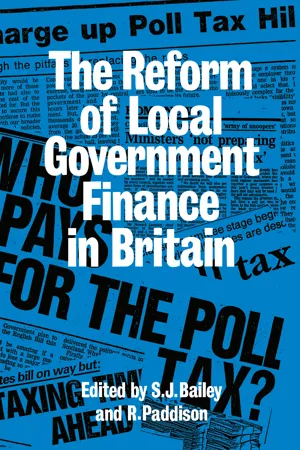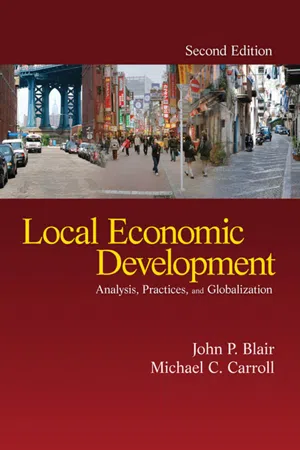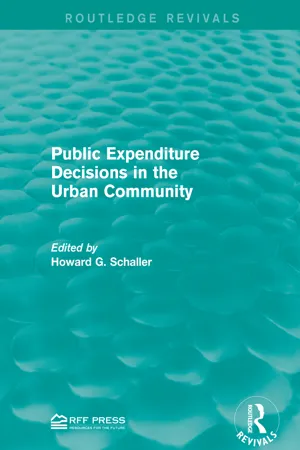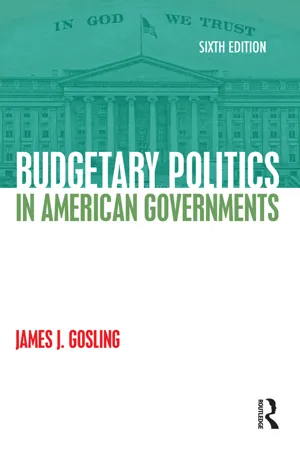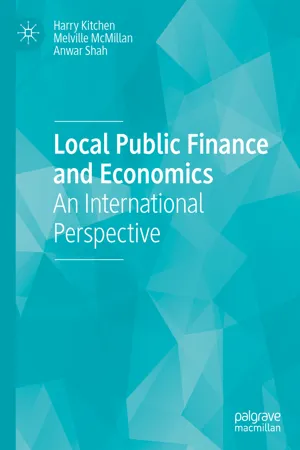Economics
Local Government Expenditures
Local government expenditures refer to the funds spent by local authorities on public services and infrastructure within their jurisdiction. These expenditures typically cover areas such as education, public safety, transportation, and social services. Local government expenditures play a crucial role in shaping the quality of life and economic development within a community.
Written by Perlego with AI-assistance
Related key terms
6 Key excerpts on "Local Government Expenditures"
- eBook - ePub
- Ronan Paddison, S. J. Bailey(Authors)
- 2013(Publication Date)
- Routledge(Publisher)
Chapter TenLOCAL GOVERNMENT FINANCE AND MACROECONOMIC POLICY
Richard JackmanINTRODUCTION
Because Governments are concerned with the overall management of the economy, they have to be concerned with the amount of local authority expenditure, borrowing and taxation (Department of the Environment, 1986, para 1.13)In 1985, local authorities in the United Kingdom spent in total nearly £42 billion, which amounts to just over 25 per cent of all government expenditure and to about £750 per head of population. Their ‘final’ expenditure on goods and services amounted to just over 10 per cent of the gross national product.(1) Local government is therefore by any standards a major sector of the economy. The size of the sector, and the management of resources within it, are therefore inevitably important in terms of national economic well-being, or with the ‘overall management of the economy’, using that term in its broadest sense.To accept that central government has a legitimate concern with the overall level of local government spending is not to imply a blanket justification for central intervention into local affairs. Local authorities are independently constituted political organisations empowered to make decisions both on the totality of their expenditure and on its allocation between services. While local authority spending decisions clearly matter, the key issue is whether the independent decisions of local authorities acting primarily in pursuit of local interests will at the same time be in the best interests of the nation as a whole. Is there a national interest in the level of local government spending different from the local interest, and if so why and of what form? If such a divergence is identified, what types of policy intervention might it justify and can such policies be made to work effectively and without adverse side-effects? - eBook - ePub
Local Economic Development
Analysis, Practices, and Globalization
- John P. Blair, Michael Charles Carroll(Authors)
- 2008(Publication Date)
- SAGE Publications, Inc(Publisher)
Finally, critics contend that benefit-cost studies remove decisions from the political decision makers and place them in the hands of technocrats. When benefit-cost techniques are employed, citizens lose the ability to engage in debates and affect outcomes. It is true that benefit-cost studies can be used to “snow” people and make a political decision appear to be only a technical decision. However, this abuse can be avoided in well-implemented studies.Summary
Most public programs influence economic development prospects either directly or indirectly, intentionally or unintentionally. Economic development officials are often involved in many phases of local government.The federal government has a dominant influence in stabilization activities through monetary and fiscal policy. Local governments lack the capacity to control overall levels of economic activity, but LED efforts are a form of stabilization policy. Distribution functions are also difficult to implement at the local level because of problems associated with the race to the bottom. However, modest redistribution efforts occur at the local level. Allocation activities constitute the bulk of state and local government activity. Allocation activities include the provision of public goods as well as adjusting market outcomes for externalities and merit goods.Many observers examine economies of scale to determine the appropriate size of local governments. But some economists argue that local governments can purchase services from elsewhere, so there is no need to have a government large enough to achieve economies of scale. More recently, economists have claimed that decision-making costs should be the key factor in determining government size. Three important aspects of decision-making costs are preference mismatches, decision-making effort, and intergovernmental spillovers.Efficiency of local governments may be improved by better use of prices and fees, efficient taxes, accountability including strengthening the “invisible hand in government,” intergovernmental cooperation, an effective system of grants, the distribution of functions, and privatization.Fiscal impact and cost-benefit studies are useful tools for fiscal management. Urban development specialists should understand the strengths and limitations of these tools. - eBook - ePub
- Cameron Ross(Author)
- 2008(Publication Date)
- Routledge(Publisher)
Chapter 6 , the highest share of local budget revenues come from grants and subventions, which are subject to tight controls by federal and regional administrations. In addition, as discussed below, local governments have the right to delegate expenditure functions to each other, and to date this has mainly taken the form of settlement budgets delegating some of their expenditure responsibilities to higher-level municipal districts and city districts.Key areas of municipal expenditure
As Table 7.1 shows, three items dominated municipal expenditure over the period 1996–2002: education, housing and communal services, and health and fitness. In 2002, these three areas of expenditure made up 68.2 per cent of total expenditure. Education was the largest item comprising just over one-third of total expenditures (33.2 per cent), followed by housing and municipal services (19.5 per cent), and health and fitness (15.5 per cent). There was a steady decline in local expenditures for housing and communal services as a result of ‘progress in transferring the burden of housing costs to the general population’ (see below).7 - Howard G. Schaller(Author)
- 2016(Publication Date)
- Routledge(Publisher)
Aid from the state and national governments to the cities takes many forms, including, in addition to grants and shared taxes, loans and loan guarantees, technical assistance, personnel training and research support. The programs carried out directly by the state and the national government also vitally affect standards of living and economic development in the cities. And in terms of specific services, the urban family gets from a national agency its postal services, and from both national and state agencies it receives an assurance of safety of the drugs and food it buys. A complete listing would enumerate the items of expenditure of state and national governments and include that largest item of public outlay—national defense. The beneficiary groups for all the programs-local, state, and national—are families and the businesses that serve them. When the state provides unemployment insurance; or the national government, retirement benefits, the city's welfare rolls are reduced; and when the state locates a branch of a state university in a city the pressures on the city for higher educational facilities are relieved. These are examples of the complex intergovernmental expenditure impacts omitted from the present review.The distribution of responsibility among levels of government for civilian public services attests to the success of the grant-in-aid and tax-sharing devices for intergovernmental co-operation. Local services are provided close to home with aid from state and national governments. The national government directly provides only a small part of civilian public services to the urban resident. In all, less than 8 per cent of all governmental purchases of goods and services are made in the course of administering national programs for civilian public services. Of the total state and local expenditures, localities account for almost two-thirds.The amount of state aid to local government has increased over the past decade from about $4 billion in 1950 to over $9 billion in 1960, but state aid as a per cent of local general revenue has dropped off. While the figures cited include payment received from the state as reimbursement and sharing of the costs of services, they mainly represent grants in-aid and share of taxes. About $7 billion of the $9 billion total was raised by the states through taxation, and more than $5 billion went to the local communities for schools. The remaining $2 billion total is approximate, since federal grants to a state become state monies and are not separately identified in the subsequent redistribution within the state.2- eBook - ePub
- James J. Gosling(Author)
- 2015(Publication Date)
- Routledge(Publisher)
8 Budgeting in Local Units of Government
DOI: 10.4324/9781315673714-8The U.S. Constitution makes no reference to local units of government, which are legally creatures of the states, dependent on those states for their creation and continued existence. States must expressly enumerate the powers and rights of local governments, and the latter are without authority to act unless their actions fall within the powers granted to them by state constitution or statute.Given this dependency, local units of government are subject to state constitutional or statutory requirements that they balance their budgets for each fiscal year, paralleling the same legal requirement for all state governments except Vermont. In theory, the requirement means that local governments must enact budgets that are in balance, including sufficient appropriated revenues to cover budgeted expenditures. In practice, the budget can get out of balance during the course of the fiscal year; in extreme cases, a deficit may result at the close of a fiscal year despite efforts to cut back on discretionary spending late in the year. When revenues fall significantly short of projections, local policy makers find it difficult to bring the budget into balance through spending reductions, since a high percentage of local budgets—particularly those of municipalities—goes to cover the salaries and fringe benefits of employees, who usually have civil service protection. Thus, program administrators have only marginal flexibility in reducing expenditures late in the fiscal year as an adjustment to revenue shortfalls. Faced with a deficit at year’s end, budget makers must enact a budget for the coming fiscal year that not only eliminates the carried-forward deficit but also closes the new year in the black.Because of the nature of local governmental budgets, local budgeting can most aptly be described as revenue budgeting. Expenditures must be approved at levels that fall within projected revenue availability. Few incentives, political or other, prompt local budget makers to enact budgets that appear to be in balance at time of passage but hold little promise of staying in balance through the close of the fiscal year. The political risks of running in the red are too high. Although a deficit calls into question the managerial competence of both the chief executive and the legislative body, most often it is the mayor or county executive, rather than the municipal council or county board, who bears the brunt of criticism. - eBook - ePub
Local Public Finance and Economics
An International Perspective
- Harry Kitchen, Melville McMillan, Anwar Shah(Authors)
- 2019(Publication Date)
- Palgrave Macmillan(Publisher)
© The Author(s) 2019 H. Kitchen et al. Local Public Finance and Economics https://doi.org/10.1007/978-3-030-21986-4_6Begin Abstract6. Expenditures and Service Delivery: Social Services
End AbstractHarry Kitchen1,Melville McMillan2andAnwar Shah3(1) Department of Economics, Trent University, Peterborough, ON, Canada(2) University of Alberta, Edmonton, AB, Canada(3) Governance Studies, Brookings Institution, Washington, DC, USAAnwar ShahIntroduction
During the second half of the last century, there was dramatic growth in government, especially in the industrialized countries. Across 17 industrialized countries, Tanzi and Schuknecht (1995 ) report that the ratio of government expenditures (G) to GDP increased from 27.9 percent to 47.2 percent between 1960 and 1994. Growth in social spending was the main driver of that growth in government. For that group and time, social expenditures increased from 10.1 to 21.7 percent of GDP and those for subsidies and transfers rose from 8.3 to 23 percent. More recently, the G/GDP ratio has not only stabilized but has declined slightly, to where G is an average of 43.9 percent of GDP, in part due to declining interest rates and debt-servicing costs (Schuknecht and Tanzi 2004 ).1Governments have typically had a role in providing social programs and, clearly, that role has increased. Governments’ role in providing assistance for the needy has resulted because the care available from religious and volunteer groups has usually been considered insufficient (and vice versa). Also, over time, a social safety net has come to be recognized as supporting market specialization, labor mobility, and risk taking; benefits that take on more relevance as trade and international trade expands. Governments have usually played a particularly prominent role in schooling and education. The increasing importance of education and skills in the labor market has pushed the public role further as secondary education became the norm and post-secondary (vocational and academic) education is increasingly expected by employers. Advances in health services have expanded the benefits from quality medical and hospital care. While the benefits increased, so have the costs. Public health insurance has been widely adopted as a means to ensure general access at reasonable cost. Public health programs have usually included public delivery of significant components of the system, especially hospitals. Overall, public social programs have grown substantially largely because they afforded a popular means of sharing risk and of realizing growing benefits.
Index pages curate the most relevant extracts from our library of academic textbooks. They’ve been created using an in-house natural language model (NLM), each adding context and meaning to key research topics.
